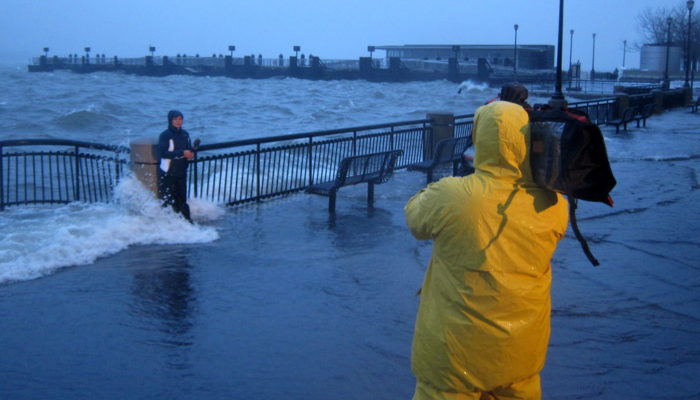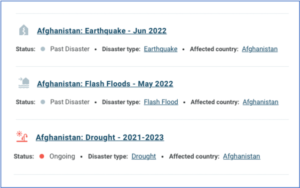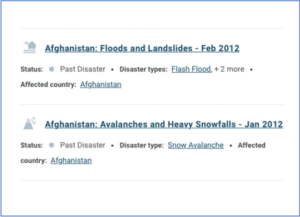
Connecting the dots: the importance of recognising multi-hazard events in disaster reporting
By Sophie Buijs and Marleen de Ruiter
In the past year, the world has witnessed many severe disasters caused by multiple hazards whose impacts overlapped in time and space. February this year, two severe earthquakes hit Syria and Turkey shortly after each other, followed by two more powerful earthquakes and over a hundred aftershocks in subsequent weeks [1,2]. The disaster caused over 48 thousand fatalities, and many people are still missing [3]. Another example is Afghanistan in June 2022, where an earthquake struck when people were already affected by a multi-year drought, followed by extreme rainfall and flooding in August [4,5]. Pakistan too was faced with an unfortunate series of events over the course of 2022. After a period of drought, heatwave-induced glacier melting combined with a heavy rain season resulted in devastating flooding, landslides, and disease outbreaks [4,6]. Additionally, the country was dealing with severe wildfires in May and June 2022 [7].
The United Nations Office for Disaster Risk Reduction defines such complex events as multi-hazard events involving the simultaneous or sequential occurrence of two or more hazards and their potentially interrelated effects [8]. For example, the flash floods in Pakistan were likely exacerbated by the wildfires in other regions [7]. Due to connections and feedback between multiple events, the combined impact of a multi-hazard event can be different from the sum of the impacts of multiple individual disasters [9].
Despite growing awareness among disaster risk researchers and managers of the importance of adopting a multi-hazard approach [10,11], complex multi-hazard events are often not recognised and reported upon as such by the mainstream media and disaster reporting websites. Such a fragmented approach to disaster reporting can result in an incomplete understanding of disasters and their impacts. It can limit the general public awareness of multi-hazard disasters, which in turn can affect disaster risk reduction and resilience-building efforts.
For example, regarding the Afghanistan hazards, ReliefWeb – a humanitarian information service provided by the United Nations Office for the Coordination of Humanitarian Affairs (OCHA) – reports the drought, earthquake, and flood as three separate disasters (Fig 1). The coincidence of these hazards is only briefly, and in some cases not at all, mentioned in the descriptions of the individual disasters [12-14].

In some instances, disasters are reported together (Fig 2), but this mainly occurs in the case of physically dependent disasters (i.e. where the occurrence of one hazard triggers that of another), while a multi-hazard event can also consist of multiple independent hazards with overlapping impacts [9].

This single-hazard-oriented reporting that can be observed in the provision of information by ReliefWeb and other humanitarian information services is also reflected in the way that disaster data is reported by aid organizations such as the International Federation of Red Cross and Red Crescent Societies (IFRC), but also more scientific sources, such as the Emergency Events Database EMDAT or the UNDRR’s Desinventar databases. The data that can be retrieved from these sources provide information per event, looking at one hazard at a time [16-18]. EMDAT provides a column for ‘associated disasters’, but this accounts, again, only for associations between physically dependent hazards.
For example, the two tropical cyclones that hit northern Mozambique in 2019 only six weeks apart; these are not associated with each other in the EMDAT database, while the impacts of the second cyclone compounded with the residual impacts of the first [19]. The sequential disease outbreak resulting from the sanitation infrastructure disruptions [20] is also not linked to the storms as an associated disaster. While it is understandable that attributing impacts to individual natural hazards can be relevant for research purposes, it can be questioned if attributing impacts or emergency funding to single hazards is even possible when disaster impacts are strongly intertwined.
Also, inconsistent and single-hazard-oriented reporting can often be observed when it comes to multi-hazard events in the mainstream media. When reporting on the first two severe earthquakes that struck Syria and Turkey in early February this year, the Guardian, for example, inconsistently uses ‘earthquake’ and ‘earthquakes’ in their articles:
Two weeks after the Turkey-Syria Earthquakes – a photo essay
Guardian article by Lorenzo Tondo and Ruth Michaelson, published February 21, 2023
Thousands dead, millions displaced: the earthquake fallout in Turkey and Syria
Guardian article by Oliver Holmes, Elena Morresi and Finbarr Sheehy, published February 21, 2023
Another example is an article in the New York Times regarding the floods and looming food crisis faced by Pakistan in 2022:
‘Very Dire’: Devastated by Floods, Pakistan Faces Looming Food Crisis
New York Times article by Christina Goldbaum and Zia ur-Rehman, published September 11, 2022
While the article explains how the floods affected the country’s agricultural sector, for example, through the destruction of crops, this provides a simplified view of the actual situation. The food security conditions in the region, while worsened by the flood impacts, were already dire prior to the floods due to the drought and heat wave in early 2022, combined with economic instability and political unrest [21]. Research has shown that both consecutive hazard conditions and unstable socio-economic conditions can significantly affect the impacts of such a multi-hazard disaster [22].
However, recent news articles have taken initial steps towards a more comprehensive multi-hazard approach to disaster reporting. There are examples of articles discussing multiple hazards and their interconnections, like this article by the Guardian:
Bushfires, ash rain, dust storms and flash floods: two weeks in apocalyptic Australia
Guardian article by Kate Lyons, published January 24, 2020
This comprehensive article explains the natural hazards experienced by Australia in 2019-2020 (i.e. bushfires, extreme rain, flash floods, heatwave, mud streams, drought, dust and hail storms) and how they were interconnected. Recently the BBC even used the term ‘multi-hazard’ in their reporting [23]. This is a positive trend that should be continued into the future.
The widespread panic and confusion currently observed in Syria and Turkey after the second set of severe earthquakes hit make painstakingly clear how important it is to increase our awareness of and resilience to the risks faced when hit by multi-hazard events. Disaster reporting can be crucial in consistently recognising and reporting multi-hazard events discussing (potential) interconnections between hazards. This requires a shift from a fragmented to a more comprehensive approach to disaster reporting, including more frequent and consistent use of multi-risk terminology and adopting a broader definition of multi-hazard events. Improved recognition of multi-hazard events in disaster reporting will provide a more accurate representation of such complex disasters and their impacts, enhancing public awareness and understanding of multi-hazard events. Additionally, more attention to interconnected natural hazards in the reporting of official disaster data can support disaster risk science and management efforts.
References
[1] United Nations Office for the Coordination of Humanitarian Affairs (OCHA). (2023, Feb. 6). Earthquake: Turkiye and north-west Syria Flash Update No. 1 As of 6 Februari 2023. Retrieved from https://reliefweb.int/report/turkiye/earthquake-turkiye-and-north-west-syria-flash-update-no-1-6-february-2023
[2] Union of Medical Care and Relief Organizations (UOSSM). (2023, Feb. 20). Two new earthquakes rock Syria and Turkey. Retrieved from https://reliefweb.int/report/syrian-arab-republic/two-new-earthquakes-rock-syria-and-turkey
[3] Cable News Network (CNN). (2023, Feb. 22). How to help victims of the earthquake in Turkey and Syria. https://edition.cnn.com/2023/02/06/world/iyw-how-to-help-turkey-syria-earthquake-victims/index.html
[4] United Nations Economic and Social Commission for Asia and the Pacific (ESCAP). (2023, Jan. 4). 2022: A year when disasters compounded and cascaded. Retrieved from https://reliefweb.int/report/world/2022-year-when-disasters-compounded-and-cascaded
[5] World Food Programme (WFP). (2022, Dec. 22). WFP Afghanistan: Situation Report 22 December 2022. Retrieved from https://reliefweb.int/report/afghanistan/wfp-afghanistan-situation-report-22-december-2022
[6] Ishaque, W., Tanvir, R., & Mukhtar, M. (2022). Climate Change and Water Crises in Pakistan: Implications on Water Quality and Health Risks. Journal of Environmental and Public Health, 2022.
[7] Kahn, R.S. (2022, Sep. 19). Long-term impacts of ‘terrible’ fire season in Pakistan’s mountains. Retrieved from https://www.preventionweb.net/news/long-term-impacts-terrible-fire-season-pakistans-mountains
[8] United Nations Office for Disaster Risk Reduction (UNDRR). (2017). Terminology for Disaster Risk Reduction, Geneva, Switzerland.
[9] de Ruiter, M. C., Couasnon, A., van den Homberg, M. J. C., Daniell, J. E., Gill, J. C., & Ward, P. J. (2020). Why We Can No Longer Ignore Consecutive Disasters. Earth’s Future, 8(3).
[10] International Science Council (ISC), United Nations Office for Disaster Risk Reduction (UNDRR), and Integrated Research on Disaster Risk (IRDR). (2021). A Framework for Global Science: in support of Risk Informed Sustainable Development and Planetary Health. Retrieved from https://council.science/wp-content/uploads/2020/06/DRR_GlobalScience-Framework-FINAL.pdf
[11] Ward, P. J., Daniell, J., Duncan, M., Dunne, A., Hananel, C., Hochrainer-Stigler, S., Tijssen, A., Torresan, S., Ciurean, R., Gill, J. C., Sillmann, J., Couasnon, A., Koks, E., Padrón-Fumero, N., Tatman, S., Tronstad Lund, M., Adesiyun, A., Aerts, J. C. J. H., Alabaster, A., … De Ruiter, M. C. (2022). Invited perspectives: A research agenda towards disaster risk management pathways in multi-(hazard-)risk assessment. Natural Hazards and Earth System Sciences, 22(4), 1487–1497.
[12] ReliefWeb. (2023, Feb. 15). Afghanistan: Drought – 2021 – 2023. Retrieved from https://reliefweb.int/disaster/dr-2021-000022-afg
[13] ReliefWeb. (2023, Feb. 15). Afghanistan: Earthquake – Jun 2022. Retrieved from https://reliefweb.int/disaster/eq-2022-000232-afg
[14] ReliefWeb. (2023, Feb. 16). Afghanistan: Flash Floods – May 2022. Retrieved from https://reliefweb.int/disaster/ff-2022-000209-afg
[15] ReliefWeb. (2023, Feb. 16). Afghanistan – Disasters. Retrieved from https://reliefweb.int/disasters?search=afghanistan
[16] Centre for research on the Epidemiology of Disasters (CRE). (2023, Feb. 21). EM-DAT – The International Disaster Database. Retrieved from https://public.emdat.be
[17] International Federation of Red Cross and Red Crescent Societies (IFRC). (2023, Feb. 22). Federation-wide databank and reporting system. Retrieved from https://data.ifrc.org/FDRS/
[18] United Nations Disaster Risk Reduction (UNDRR). (2023, Feb. 21). DesInventar Sendai. https://www.desinventar.net
[19] International Federation of Red Cross and Red Crescent Societies (IFRC). (2022, Dec. 6). Mozambique: Tropical Cyclones Idai and Kenneth – Emergency Appeal n° MDRMZ014, Final Report. https://reliefweb.int/report/mozambique/mozambique-tropical-cyclones-idai-and-kenneth-emergency-appeal-ndeg-mdrmz014-final-report
[20] Cambaza, E., Mongo, E., Anapakala, E., Nhambire, R., Singo, J., & Machava, E. (2019). Outbreak of Cholera Due to Cyclone Kenneth in. International Journal of Environmental Research and Public Health, 16, 3–9.
[21] Integrated Food Security Phase Classification (IPC). (2022, Dec. 30). Pakistan, Sindh: IPC Acute Food Insecurity Analysis July – December 2022. Retrieved from https://reliefweb.int/report/pakistan/pakistan-sindh-ipc-acute-food-insecurity-analysis-july-december-2022-published-december-30-2022
[22] Matanó, A., De Ruiter, M. C., Koehler, J., Ward, P. J., & Van Loon, A. F. (2022). Caught between extremes: Understanding human-water interactions during drought-to-flood events in the Horn of Africa. 1–20.
[23] British Broadcasting Corporation (BBC). (2023, Jan. 4). Severe weather causes havoc across the US. Retrieved from https://www.bbc.com/news/av/world-us-canada-64169902
